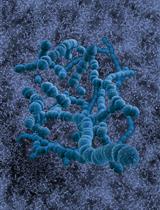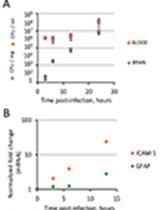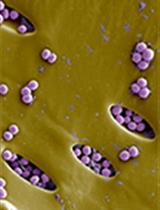- EN - English
- CN - 中文
Induction of Acute or Disseminating Bacterial Pneumonia in Mice and Sampling of Infected Organs for Studying the Host Response to Bacterial Pneumonia
小鼠急性或播散性细菌性肺炎的诱导和感染器官取样研究宿主对细菌性肺炎的反应
发布: 2022年01月05日第12卷第1期 DOI: 10.21769/BioProtoc.4287 浏览次数: 4218
评审: Alexandros AlexandratosEmilie BesnardGuangzhi Zhang
Abstract
Experimental pneumonia models are important tools to study the pathophysiology of lung inflammation caused by microbial infections and the efficacy of (novel) drugs. We have applied a murine model of pneumonia induced by Pseudomonas (P.) aeruginosa infection to study acute host antibacterial defense in lungs, and assess epithelial cell specific responses as well as leukocyte recruitment to the alveolar space. To study host responses during disseminating pneumonia, we also applied a model of infecting mice with hypermucoviscous Klebsiella (K.) pneumoniae. In the latter model, K. pneumoniae is restricted to lung during the early phase of infection and at the later time points disseminates to the circulation and distal organs resulting in sepsis. Detailed procedures for induction of pneumonia in mice by Pseudomonas and Klebsiella and for isolation and analysis of infected organs, bronchoalveolar fluid, and bronchial brushes are provided in this article.
Background
Epithelial cells and innate immune cells (alveolar macrophages and neutrophils) constitute the first line of defense in the lung against infection (Whitsett and Alenghat, 2015). Pseudomonas (P.) aeruginosa and Klebsiella (K.) pneumoniae are among the most frequent causative bacterial pathogens for hospital-acquired pneumonia, and the latter is a common cause of pneumonia-derived sepsis (Angus and van der Poll, 2013). Both lung epithelial cells and myeloid cells play vital roles in lung immune response against acute airway P. aeruginosa infection, partially depending on the bacterial expression of flagellin, and expression of Toll-like receptor 5 on the surface of lung epithelial cells (Kannan et al., 2009; Mijares et al., 2011; Lovewell et al., 2014). We developed Procedure A to evaluate the lung epithelial cell specific and myeloid cell specific role during P. aeruginosa infection in mice (Qin et al., 2020). In this model, P. aeruginosa is efficiently cleared from the lung within 24 h after infection and does not disseminate to other organs (Anas et al., 2016; Qin et al., 2020; Qin et al., 2021a). Considering that pneumonia is one of the leading causes of sepsis, we also utilized a murine model with hypermucoviscous K. pneumoniae (Procedure B), which disseminates from the lung to other organs, and mimics aspects of pneumonia-derived sepsis (de Stoppelaar et al., 2014; Anas et al., 2017; Qin et al., 2021a). In this sepsis model, we evaluate the lung immune defense as well as systemic responses by measuring bacterial burden, inflammatory cytokine production, and pathological changes in both lung and distal organs. Procedure A is also applicable to study lung immune responses or inflammation induced by intranasal inoculation of Methicillin-resistant Staphylococcus aureus (Meijer et al., 2021), or bacterial compounds, such as flagellin (Qin et al., 2021b) and lipopolysaccharide (Otto et al., 2020). Procedure B can also be applied to study Streptococcus pneumoniae–evoked pneumonia-derived sepsis (van der Windt et al., 2011; Achouiti et al., 2014; Hommes et al., 2014; van den Boogaard et al., 2018; de Porto et al., 2019).
Materials and Reagents
Eight- to twelve-week-old specific pathogen free (SPF) male and female C57BL6 mice (The Jackson laboratory, Charles River or Harlan) (usually 8 mice per group based on power calculation, see below)
Blood agar plates (Biomerieux, catalog number: 1008498740)
Silk suture (Mersilk 5-0, Ethicon, catalog number: W580)
1 mL syringes (BD Plastipak, catalog number: 2102196)
25 G needles (BD Microlance, catalog number: 300600)
22 G I.V. cannula (ICU Medical, catalog number: 95-201-KY)
PE50 polyethylene tubing (Becton Dickinson, 7248724)
Sandpaper (3M, catalog number: P240)
50 mL polypropylene tubes (Sarstedt, catalog number: 1040721)
5 mL polypropylene tubes (Greiner Bio-One, catalog number: 21130132)
1.5 mL eppendorf tubes (Greiner Bio-One, catalog number: 616201)
2.0 mL eppendorf tubes (Sarstedt, catalog number: 0084421)
Micronic tubes (Micronic, catalog number: MP22400)
96-well U bottom plates (Greiner Bio-One, catalog number: E21023FE)
0.5 mL heparin minicollect tube (Greiner Bio-One, catalog number: CA20074MH)
Bacteria
Pseudomonas aeruginosa strains PAK (ATCC-25102; Qin et al., 2021a) and PAO1 (ATCC-15692; Anas et al., 2016; Qin et al., 2020), frozen stock in 15% glycerol with 4 mm sterile glass beads.
Klebsiella pneumoniae serotype 2 (American Type Culture Collection, catalog number: 43816), frozen stock in 15% glycerol with 4 mm sterile glass beads.
Tryptic soy broth (TSB, Becton Dickinson, catalog number: 211825)
Sterile 0.9% NaCl (Baxter Healthcare AS, catalog number: 21BO3BB1B)
Sterile phosphate-buffered saline (PBS) (Fresenius Kabi, catalog number: 16PK9479)
70% ethanol (Added Pharma, catalog number: ROL1642610)
Isoflurane (Isoflutek, Laboratories Karizoo, catalog number: Reg NL 118938)
10% (100 mg/mL) ketamine (Alfasan, catalog number: Reg. NL 5811 UDD)
0.5 mg/mL dexmedetomidine (Dexdomitor, catalog number: Reg. NL 10306)
0.5 M EDTA solution (ThermoFisher, catalog number: 15575020)
RNaseZap (ThermoFisher, catalog number: AM9780)
Pathology cassette (Epredia, catalog number: 22272418)
4% Formaldehyde (10% formalin, ProPath)
Protease inhibitor cocktail tablets inhibitor (Merck, catalog number: 11836145001)
NucleoSpin columns RNA isolation kit (Macherey Nagel, catalog number: 1911/004)
MMLV reverse transcriptase (Promega, catalog number: M1705)
Cytometric Bead Array (CBA) mouse inflammation kit (BD Biosciences, catalog number: 552364)
ELISA kits (R&D Systems, catalog numbers: DY401 [IL1β], DY406 [IL6], DY410 [TNF], DY453 [CXCL1], DY443 [CXCL5], DY760 [CCL20], DY3667 [myeloperoxidase], and DY4517 [elastase])
Antibodies for flow cytometry
Rat anti-mouse CD11b PE-Cy7 (clone M1/70; BD Biosciences, catalog number:561098)
Rat anti-mouse Siglec-F Alexa Fluor 647 (clone E50-2440; BD Biosciences, catalog number: 562680)
Rat anti-mouse Ly-6C Alexa Fluor 700 (clone AL-21; BD Biosciences, catalog number: 561237)
Rat anti mouse-CD45 PE-eFluor610 (eBiosciences, 30-F11, catalog number: 61-0451-82)
Rat anti-mouse Ly-6G FITC (clone 1A8; Biolegend, catalog number: 127605)
Counting beads (Biolegend, catalog number: 424902)
Pierce BCA protein assay kit (ThermoFisher, catalog number: 23225)
Hematoxylin solution (VWR International, catalog number: VWRK4085.9002)
Eosin Y disodium salt (Sigma-Aldrich, catalog number: E6003-25G)
Tris base (Merck, catalog number: 11814273001)
MgCl2·6H2O (Merck, catalog number: 1058330250)
Triton X-100 (Merck, catalog number: X100-1L)
32% HCl solution (Merck, catalog number: 1003191011)
Luria broth (LB, Becton Dickinson, catalog number: 244620)
Luria-Bertani (LB) medium (see Recipes)
Tryptic Soy Broth (TSB) medium (see Recipes)
Ketamine/Dexmedetomidine (see Recipes)
2× Cell lysis buffer (CLB, see Recipes)
2 mM EDTA-PBS solution (see Recipes)
Equipment
ABSL-2 biosafety cabinet (Biohazard, catalog number: EN12469)
Microbiological Incubator (Panasonic, model: MIR-254-PE)
Spectrophotometer (Merck, model: Spectrophotometer Pharo 100)
Centrifuge (Hettich, model: Riotina 380R)
DNA/RNA UV-cleaner box (Biosan, model: UVT-B-AR)
Vortex (VWR International, catalog number:111336624)
Anesthesia vaporizer (Datex-Ohmeda, model: Tec7)
Microtome (Leica, model: RM2245)
Surgical scissors
Fine forceps
Pipettes (Sartorius, models: P20, P200 and P1000)
Multi-channel pipettes (Sartorius, models: P50 and P300s)
Homogenizer (Qiagen, model: 985370-395)
pH meter (Hanna Instruments, catalog number: HI2210-02)
L-Shaped disposable spreaders (Thomas Scientific, catalog number: 1202F84)
-80°C freezer (Panasonic, catalog number: 13010003)
-20°C freezer (Sanyo, catalog number: alt-314)
LightCycler 480 real-time PCR system (Roche, catalog number: D10003)
Synergy multi-mode microplate reader (BioTek, catalog number: 232560)
Cytoflex S (Beckmann Coulter, catalog number: B75442)
Software
GraphPad Version 8.0 (GraphPad Software)
FlowJo software (Becton Dickinson)
Power calculation for group size (https://clincalc.com/stats/samplesize.aspx)
Procedure
文章信息
版权信息
© 2022 The Authors; exclusive licensee Bio-protocol LLC.
如何引用
Qin, W., Liu, Z., van der Poll, T. and F. de Vos, A. (2022). Induction of Acute or Disseminating Bacterial Pneumonia in Mice and Sampling of Infected Organs for Studying the Host Response to Bacterial Pneumonia. Bio-protocol 12(1): e4287. DOI: 10.21769/BioProtoc.4287.
分类
免疫学 > 宿主防御 > 鼠
微生物学 > 体内实验模型 > 细菌
分子生物学
您对这篇实验方法有问题吗?
在此处发布您的问题,我们将邀请本文作者来回答。同时,我们会将您的问题发布到Bio-protocol Exchange,以便寻求社区成员的帮助。
提问指南
+ 问题描述
写下详细的问题描述,包括所有有助于他人回答您问题的信息(例如实验过程、条件和相关图像等)。
Share
Bluesky
X
Copy link












